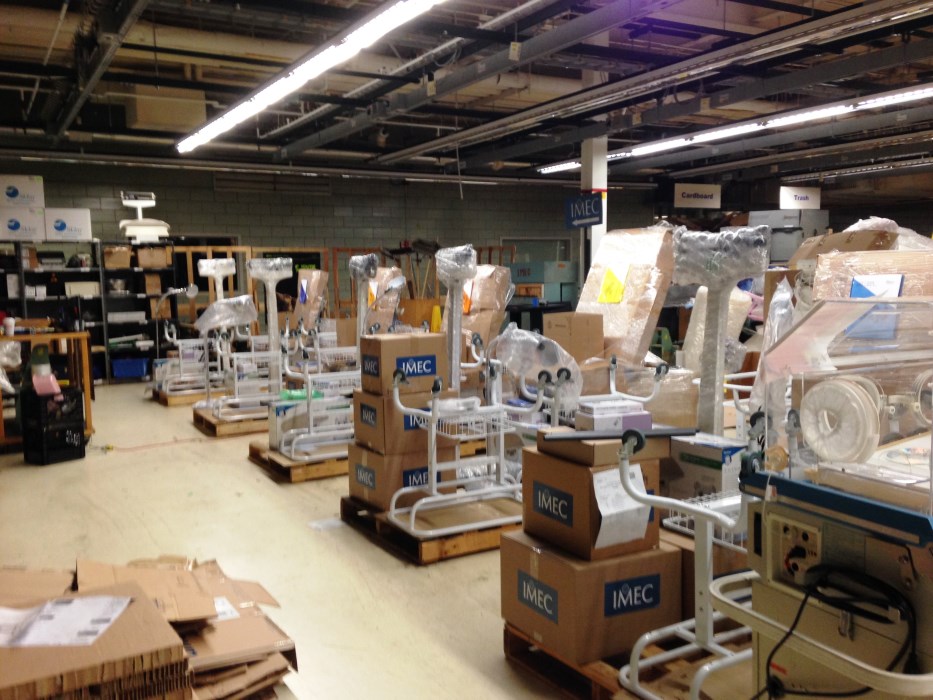Rotarians Outfit Neonatal Clinics in Mongolia
By PDG Tony Gilmore, District 7870

Packing equipment for neonatal clinics in Mongolia.
Rotary Ambassadorial Scholar Batuka Baterdene, from Mongolia, had a dream when he came to the United States in 2012 to pursue a degree in city planning at the State University of New York (SUNY) Albany. It was his goal to equip five rural clinics in his home country with the medical equipment needed to provide care to expectant mothers and their infants in villages that were sometimes hundreds of miles from the nearest hospital.
At Northeast LINK, a Rotary forum held annually in Massachusetts for Rotary scholars and outgoing Group Study Exchange teams, Batuka made a presentation that demonstrated the desperate need of the clinics. His presentation was enhanced by a series of compelling videos taken by two expat members of Mongolia’s Ulaanbaatar Rotary Club.
Batuka's presentation struck a chord with me. I told him that I'd like to help, but it would have to be after my Governor year ended in June 2013. With the help of the videos, we put together a presentation and took it to as many Rotary clubs as possible through the summer and into the fall and winter of 2013-14.
A governor classmate got involved. Her District 7780 had sent a medical team to visit Mongolia via a Group Study Exchange to District 3450 several years previously. And as luck would have it, the leader of that GSE team, Dr. Burt Dibble, was now president of his Exeter, NH, club and in a position to help.

A mother nurses her newborn in Mongolia.
Batuka returned to Mongolia that winter, and we communicated via email and social media. Batuka found a host club, Ulaanbaatar Peace Avenue Club, and every member of that club contributed financially to the project. They secured the necessary Memos of Understanding from the government to ensure that the donation would not be taxed; from the Medical University to ensure appropriate training at each clinic; and from the clinics themselves, to ensure that they understood the equipment was only to be used for its intended purpose.
Meanwhile the equipment list was being refined. High-tech equipment needed included solid-state sonogram units, fetal heart monitors and the incubators. Particular attention was paid to the local power sources; power conditioning equipment was used to protect the sensitive equipment. LED lighting avoids the problem of burned-out bulbs and the sterilizers are non-electrified "Pot Sterilizers" - meaning any heat source will do. Almost all of the durable equipment is mechanical to eliminate specialized repair should it be damaged or broken. In all, IMEC (International Medical Equipment Consortium), headquartered in Andover, MA, provided almost $800,000 in equipment and supplies to make up the five suites.
The Global Grant for $65,000 - primarily the cost to ship a 40-foot container of medical equipment 12,000 miles plus some training and transportation costs in Mongolia was approved by The Rotary Foundation in July, and at that point, IMEC began to assemble the equipment. Once assembled and loaded, the equipment will take approximately 72 days to reach Ulaanbaatar.
Our biggest challenge may well prove to be the weather! In past years it has snowed in August -- as we write this we're all hoping that the first snows will be late. The equipment is set to arrive in November, and when it does, a representative of each of the clinics will come in for a one-day training session. Some may have to travel as much as 1700 miles to reach Ulaanbaatar. After a re- fresher course, each will accompany their equipment back to their clinic. I plan to be there along with other representatives of my D-7870 (Vermont and New Hampshire), and former GSE team leader Burt Dibble from D-7780 is also hoping to make the trip.
It started as an impossible dream. Outfitting five neonatal clinics in remote areas half a world away could never be easy. But the Rotary world is a connected place - and with the help of many Rotarians in New England and Mongolia, the nearly impossible is now taking place.